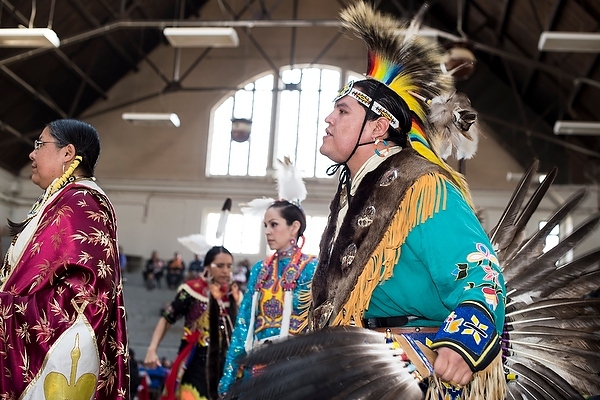New website helps educators teach about American Indian nations

Members of Native American tribes participate in a grand entry drumming and dance ceremony during a Spring Powwow at the UW–Madison Stock Pavilion.
Twelve American Indian nations call Wisconsin home. Each has its own customs, its own identity, its own story.
A new website, WisconsinAct31.org, is helping educators throughout the state tell those stories to students from kindergarten through high school. Wisconsin Act 31 is the term for the five state statutes that require schools to teach American Indian Studies throughout a student’s career and maintain instructional materials that appropriately reflect diverse cultures.
The site aims to help administrators and teachers have an online home for materials that will start classroom conversations through questions such as: How long have humans lived here? On whose ancestral lands do you live? Who are your contemporary tribal neighbors today?
Aaron Bird Bear
A statewide survey launched in 2014 and answered by more than 1,700 teachers found that two-thirds of the respondents indicated a need for support in identifying appropriate resources for teaching and learning about the American Indian nations and tribal communities of Wisconsin.
“People have very little knowledge about who native people are today. We don’t understand the history, the complexity of the diversity within Indian nations,” says Aaron Bird Bear, the American Indian Curriculum Services coordinator supporting the School of Education‘s integration of American Indian Studies content into teacher education programs.
Bird Bear (Mandan, Hidatsa, & Dine nations) received his master’s degree in educational leadership and policy analysis from UW–Madison and previously coordinated American Indian Student Academic Services, a unit supporting Native American students at UW–Madison.
State legislators in 1989 passed five educational statutes in the biennial budget bill, Act 31, in an effort to infuse American Indian Studies into public education. Since that time, Wisconsin has required instruction in the history, culture and tribal sovereignty of the federally recognized tribes and bands in the state at both K-12 schools and in teacher education programs. Since July 1991, anyone seeking a license to serve as a professional educator in the state must receive instruction in these areas.
Although legislators passed Act 31 more than a quarter century ago, it has been largely unfunded and hasn’t been widely implemented. UW–Madison curriculum and instruction Professor Simone Schweber and Bird Bear secured backing from UW–Madison’s Ira and Ineva Reilly Baldwin Wisconsin Idea Endowment to design and produce the website, which is a collaboration project between eight partners, including the School of Education, Wisconsin Public Television, UW System, Wisconsin Department of Public Instruction, the University of Wisconsin-Green Bay, Wisconsin Media Lab, Wisconsin Historical Society and Wisconsin Indian Education Association.
The Act 31 requirements were designed to provide Wisconsin’s students with instruction in American Indian Studies because of its academic appropriateness and its potential to serve as a positive force with which to combat misunderstanding and social unrest.
The new website provides resources on each of the tribal nations as well as suggested lesson plans. The idea is to efficiently help educators focus their instruction on their contemporary tribal neighbors and help educators confidently identify materials and resources illuminating the cultures, languages, histories and governmental structures of the 11 American Indian nations and one non-federally recognized nor state-recognized nation of Wisconsin.
“Act 31 is an invitation to get to know the deep human story of the western Great Lakes. It helps us understand our neighbors. It helps us understand our own shared history.”
Aaron Bird Bear
“There isn’t one native identity,” says Bird Bear, who is also interim assistant dean for student diversity programs in the School of Education. “Act 31 is an invitation to get to know the deep human story of the western Great Lakes. It helps us understand our neighbors. It helps us understand our own shared history.”
Teachers have had input on the website, offering suggestions and feedback about what would be most helpful for them and their students. Some of the information is organized by theme as well as grade levels, offering suggested books and field trip ideas.
There is no shortage of information, and hopefully the new website will make it easier to find and share resources that are vetted or developed in partnership with our tribal neighbors.
“We need to fearlessly look on our history,” Bird Bear says. “We can do that with confidence because we’re in such a better place now.”


